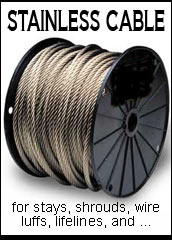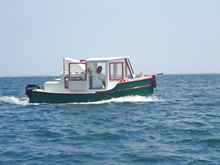
 Custom Search
|
|
| sails |
| plans |
| epoxy |
| rope/line |
| hardware |
| canoe/Kayak |
| sailmaking |
| materials |
| models |
| media |
| tools |
| gear |
 |
 |
| join |
| home |
| indexes |
| classifieds |
| calendar |
| archives |
| about |
| links |
| Join Duckworks Get free newsletter Comment on articles CLICK HERE |
|
|
| Building a Bolger Microtrawler |
by Pat Johnson
- Pensacola, Florida - USA |
PrefaceI haven’t corresponded lately but it’s not because I don’t still love you. I’ve been busy building boats. More specifically I have been building the Bolger Micro Trawler. This from the guy who wrote the Duckworks 2008 article “Need for Speed”. My wife did not like getting into “Chuggerboat". Her needs also caused me to have to build a boat large enough to have indoor accommodations. I looked at a lot of boats and plans when trying to figure out which boat might best suit my needs. I wanted it to be small enough to easily trailer while also being big enough to use on longer expeditions on the water. I finally settled on the Bolger Micro Trawler for a variety of reasons that all coincided with my reasons for building in the first place. Building a Bolger MicrotrawlerI love to be on the water and hate to come in so I like to camp on/near the water when possible. I used to camp on the banks of the rivers, lakes and bays but often found it difficult to find a suitable camping spot. Sometimes it would be marshy, swampy, muddy, rocky, or all private property. In the end I began using boats that I could sleep aboard. From a couple of canoes bolted together like a catamaran to pontoon boats to cabin cruisers to sailboats with cabins there was always too much compromise and too little benefit. I wanted something cheap, easy to trailer & maintain and dry. The Chuggerboat was fine for Dad and I but my wife needed/wanted indoor plumbing and privacy. I want to stay married and want my wife to go boating and camping with me. So…..in my never ending quest for a better boat I began searching for something that would satisfy my wife’s needs without compromising too much with respect to the goals of it being cheap, easy to maintain and easy to trailer. The Bolger Microtrawler seemed like a great choice. I looked at a lot of other designs but in the end kept coming back to Bolger’s boat. Since I now live in Pensacola and only a couple blocks from the bay I reasoned that the Microtrawler’s ability to plane (Speed) would allow me to get around the relatively long distances the bay and intracoastal waterways present. Those same capabilities could be held in check when not needed to conserve fuel and allow for long distance cruising on a shoestring. I began the construction in the fall of 2008. I knew I wouldn’t finish the boat but figured I could get the larger panels competed and be ready for more serious building when the spring weather came. In 2009 I spent a lot of time with my best camping/boating buddy (my dad) who was dying of cancer. Between the time with my dad and work I didn’t get much done on the Microtrawler as planned in 2009 before the weather turned too cold for Epoxy to set. My father passed late in 2009 and I retired mid-year so I had a lot more time for boatbuilding but the weather had turned cold and wouldn’t allow much building till it warmed up in the spring of 2010. The plans were pretty good with few mistakes (there were a couple) for the hull, sides and part of the sleeping compartment. From that point forward there were no plans. I guess Phil Bolger assumed anyone taking on such a large project would have the where-with-all to complete the pilothouse, interior…..without further instruction. Phil did a great job with the plans of making sure the boat would perform as designed but not much beyond that. Well I’ve built a few boats and have the capabilities to complete things like the pilot house, but I ain’t smart enough to do it fast and I’m certainly not smart enough to do it the best way. So time dragged on as I tried to complete the boat. I laid the keel the first year and covered it for the winter’s cooler temps. The next spring I started building the more complicated upper portions of the boat. After a lot of head scratching I assembled a jig to hold the side hulls (upper portion of the step keel) level while I attached them to the center hull and the structural bulkheads that would support them in the end. Building the jig was the single most helpful thing I did during the entire construction process. The other important/efficient thing I did was to apply fiberglass cloth to both sides of the plywood before ever cutting the individual parts. That allowed me to do it using a 50” roll of cloth and applying it while the plywood was laying flat on 2 saw horses. This is much easier than trying to glass the completed project. I built the entire boat on a 4X8 Harbor Freight trailer that I attached rear casters and a wheeled jack in the front and used as a dolly so I could move it in and out of my 10X17 foot fenced construction area.
I would definitely not recommend this project for a first time build. I have built enough boats to know how to “make do” and “wing it” when the plans run out of steam. Things went along pretty well in 2009 & 2010 but 2011 was another matter. I was beginning to hate the boat by then. All my other projects were small by comparison and when quickly, always with the end in sight. I actually built another entire boat during the Microtrawler construction. Lesson learned….don’t select Noah’s Arc as a first time project (and maybe not as a 33rd project either). Anyway, three years and some months later I was finally ready to get her wet. I blocked up the aft end and hoisted the entire boat up towards a tree limb from the “super-eye” that I had built into the bow. Then I simply rolled out the dolly trailer and rolled the final resting place under the hull.
I selected a long shaft 30hp Mercury 2-stroke with power tilt/trim for power. I knew I would generally only cruise at low speeds but the boat had a planning-hull and I didn’t want to go through life wondering what it would be like to get her on a plane. Bolger said a 5hp would give you steerage, a 10hp would be the most economical, a 50hp would give you 30 knots and a 25 would be the best all round motor. So I figured I’d hedge it a bit and go for the 30hp. I had the boat in & out of the water a dozen times before I finally got the prop pitch correct and got the 5500 max rpms the engine needed to be able to reach in order for it not to be lugging down all the time. I would say that if you are going to go larger than the 10hp all round slow cruise speed (7mph-8mph) outboard, the 30hp is the smallest I would go with. It gets it up on a plane but just barely (16mph top cruising speed). A little more angle on the transom would be a plus so you could trim the engine down and push the transom up for planing. You can always trim the outboard up a little after you get her up on the plane. I may install a wedge like spacer on the transom. I might also have added a little angle (1-2%) to the trim tabs/swim platforms but I think that would impact the speed even at lower speeds so I will look into the trim option first. Trim and tilt allow me to anchor in water one foot deep with the engine tiled up. I made the side doors able to swing back and remain open for the warmer months (like a jeep without the doors). The front window swings forward a little allowing for ventilation but not so far that it allows (much) water into the cabin when the spray and wind are a issue. I made a clear plastic snap on/off rear door to keep the rain out and stayed away from actual wooden doors. Seems like there would always be someone grabbing them to help climb in and out of the boat and they’d likely be easily damaged. I opted to use the boat the rest of this season before adding/modifying anything more. That will give me a chance to see what actually “needs” to be done instead of what I “think” needs to be done. Adding bells and whistles can be a never ending process with a significant diminishing return with regard to labor/time on the water. Advice…..don’t skip any steps or omit any parts in the plans. Bolger knew what he was doing and some of that only became apparent after I had constructed the boat. Things like fore and aft stringers on the side hulls were obviously needed to stiffen the bottoms of the upper side hulls and keep them from flexing when inadvertently pounding over a large wave/wake. Double up on the fiberglass tape on the hull where it will take a lot of stress from the entry into the water. Fiberglass tape 100% of both sides of all plywood joints. Make everything strong enough to climb around on cause you’ll want to get up on top of the boat from time to time. Build it to last forever. If you’re expend this much time, effort and money you don’t want to end up with a piece of junk. I tried her out several times before tagging along in the 2012 “Florida-120” event in May. The boat performed admirably for the 150 odd miles of the 5 days and 4 nights of the trip. The one thing that surprised me most about the boat wasn’t how big and comfortable the interior was or how stable she was or the 15+mph I got on plane. It was the sea kindly motion in a chop I wasn’t prepared for. Bolger and other owners had touted the speed and the comfort but had never said one word about how she handled the chop and seas. The lower pointy part of the hull where the water line is cuts through the water and throws up a bow wave that cushions and protects the flat sides from pounding. I was able to plow straight into 2ft chop and take any size wave or chop if I angled into them. And I could do it and 7mph! I thought WOW. Its like selling a car that gets 100mpg to someone and not mentioning the mileage to the potential buyer! Why wouldn’t I have known all about this virtue long before buying the plans much less before actually spending three years building the boat? I can’t figure it out. Maybe everybody that has built one has been a lake or river boater and didn’t appreciate the sea kindliness like a open water sailor does.
Although I have tons of bells and whistles to add before its anywhere near completion, She’s in the water and I’m inspired again! The boat has more interior room than a typical 30 footer with 6ft-3inch standing headroom and 2 6ft-5inch quarter births. The top of the boat is strong enough to climb/sit/stand on so there is quite a bit more room outside than initially appears. The boat seems to have no downsides other than being powered by a gasoline engine. I’ll keep you appraised as to how things work out in the long term but for now I’m giving the Bolger Microtrawler 2 thumbs up.
About the author….Pat Johnson builds boats as a hobby and has built about 30+ odd boats to date. All of the boats are less than 16ft and about half are power and the others are sail or row boats. Pat enjoys helping others get started building boats and offers to show people how it’s done if asked. Pat lives in Pensacola Florida and often sails in Pensacola Bay and surrounding rivers and lakes. Pat’s most common advise to people thinking about building a boat is to start small and start now!
|
 |




